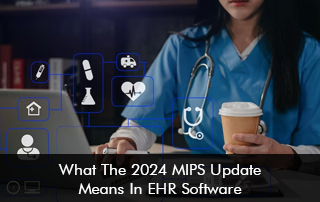EHR software goes through regular updates. One of the significant ones is the Merit-based Incentive Payment System (MIPS) update. This update brings several changes and improvements that will impact how EHR software is used. Let’s delve into what the 2024 MIPS update entails and what it means for users of EHR software.
What is MIPS?
Before diving into the updates, let’s briefly revisit what MIPS is all about. MIPS is a program introduced by the Centers for Medicare & Medicaid Services (CMS) to incentivize eligible clinicians to provide high-quality care through value-based payments. MIPS consolidates three existing quality reporting programs into one cohesive program:
- Physician Quality Reporting System (PQRS),
- Value-Based Payment Modifier (VM), and
- Medicare Electronic Health Record (EHR) Incentive Program for Eligible Professionals
The 2024 EHR Software MIPS Update: What’s New?
1. Performance Threshold Adjustments
One of the significant changes introduced in the 2024 MIPS update is the adjustment of the performance threshold. The performance threshold is the minimum score required to avoid negative payment adjustments. With the 2024 update, CMS has raised the performance threshold. This means clinicians will need to meet higher standards to avoid penalties and potentially qualify for incentives.
2. Quality Measure Changes for EHR Software
CMS regularly updates the quality measures used in MIPS to ensure they accurately reflect the quality of care provided. In the 2024 update, several new quality measures have been introduced, while others have been modified or removed. EHR software must be updated to accommodate these changes, ensuring clinicians can accurately report on the required quality measures.
3. Promoting Interoperability (PI) Category Updates
The Promoting Interoperability (PI) category of MIPS focuses on encouraging the use of certified EHR technology to support the exchange of health information and improve interoperability. In the 2024 update, there are revisions to the requirements and scoring methodology for the PI category. EHR software vendors must ensure their platforms meet the updated requirements to help users achieve high scores in this category.
4. Cost Category Adjustments
The Cost category of MIPS evaluates clinicians’ resource use by assessing the cost of care provided to Medicare beneficiaries. In the 2024 update, CMS has made adjustments to how the Cost category is calculated. This includes updates to the measures used and the weighting of this category in the overall MIPS score. EHR software should support clinicians in tracking and optimizing resource utilization to improve performance in the Cost category.
What Does This Mean for EHR Software Users?
Let’s explore what the 2024 MIPS updates mean for users of EHR software.
1. Enhanced Reporting Capabilities
With the introduction of new quality measures and changes to existing ones, EHR software users can expect enhancements to reporting capabilities. Software vendors will update their platforms to ensure clinicians can easily capture and report on the required data points to meet MIPS requirements.
2. Improved EHR Software Interoperability Features
Interoperability is a core focus of the MIPS program, and the updates in the Promoting Interoperability category underscore the importance of seamless data exchange. EHR software users can anticipate improvements in interoperability features, making it easier to share patient information securely across different systems and organizations.
3. Streamlined Workflow Integration
As MIPS requirements evolve, EHR software vendors will work to streamline the integration of MIPS-related tasks into clinicians’ workflows. This includes optimizing user interfaces, providing educational resources, and offering support to help users navigate the MIPS reporting process efficiently.
4. Continued Emphasis on Data Accuracy and Security
With the MIPS program placing a significant emphasis on data accuracy and security, EHR software users can expect continued efforts from vendors to ensure their platforms comply with stringent data standards and security protocols. This includes implementing robust data validation measures and adhering to industry best practices for protecting patient information.







